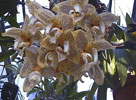|
|
|
|
|
| |
Flasks of
Stanhopea oculata '#1' × self |
|
| |
|
|
| |
| Number: |
TN3340 |
| Name: |
Stanhopea oculata '#1' × self
|
| Type: |
self (What's that?) |
|
Seed Donor: |
David R. Janvrin
|
|
Click to Enlarge

Pod Parent Flowers |
Click to Enlarge

Pod Parent Inflorescences |
Click to Enlarge

Pod Parent Closeup of Hypochile |
|
|
|
| |
Culture Notes from Donor: Flowers during the summer months on last year's growths. Grows warm and wet through the summer in bright light as for most cattleya species. May be grown in shade with some reduction in flower size and count to be expected.
Seedlings typically grown in plastic pots with bark or coconut husk chunks. Must be moved to wire baskets once they reach 4" pot size as the inflorescence grows down through the compost.
Appreciates a short winter rest with reduced water/fertilizer.
Parent plant: Temperature range I (60-83°F).
Comments: Parent plant: A highly colored cultivar from Ecuador with a distinct 'eye' spot. Though the species name, oculata, refers to the 'eye spot' on the hypochile, it is often less distinct or even missing altogether on many cultivars and is not a diagnostic characteristic for the species. Specific characteristics include the slender, close juncture of the hypochile and column and the right angle of the hypochile at the 'eye spot'
Large plant.
For additional origin/habitat information supplied courtesy of
Charles and Margaret Baker, see further below, near the bottom of this page.
|
Temperatures we attempt to use in the lab & greenhouse:
| For Species: |
|
Spring, Summer, Autumn, Winter: days average 77°F, nights 61°F; best fit is Cool-Intermediate 75-58°F
(Source:
Baker's Web OSC) |
| For Species: |
|
Winter: days average 74°F, nights 55°F; best fit is Cool-Intermediate 75-58°F
(Source:
Baker's Web OSC) |
|
About the name...
| Etymology of |
oculata |
|
From Latin "oculatus" with eye-like oval spots.
(Source:
Mayr & Schmucker 1998) |
| Etymology of |
Stanhopea |
|
In honor of Philip Henry, 4th Earl of Stanhope, president of the London Medico-Botanical Society during the early part of the 19th century.
(Source:
Pridgeon 1992) |
| Pronunciation of |
oculata |
|
ok-yoo-LAH-ta
(Source:
Hawkes 1978) |
| Pronunciation of |
Stanhopea |
|
stan-HOPE-ee-ah
(Source:
Pridgeon 1992) |
|
If you would like to direct someone to this web page, please copy and paste this URL into your email:
http://troymeyers.com/d?013340
| Flask Information |
| Availability: |
Capsules failed. We were not able to make any flasks. |
| You should: |
Consider placing a "Notify Retries" Request, and if an identical pollination (the same parents) is done again, we'll let you know. |
|
You might also want to:
|
View items of the same species.
View items of the same genus.
|
| Ordering Information |
| You are not currently logged in. |
|
You must be a registered user and be logged in to reserve a flask or place a notification request. Please log in:
|
|
|
|
|
|
| |
The origin/habitat information below is supplied courtesy of Charles and Margaret Baker
The following information is based on the name of the plant provided by the donor, and assumes that the name is correct. If the plant has been misidentified, then the following information may not be correct.
This text is copyrighted by the Bakers and may not be reproduced without permission.
ORIGIN/HABITAT: Mexico, Belize, Guatemala, Honduras, El Salvador,
Nicaragua, Costa Rica, Panama, northern South America, and Brazil. In
Mexico, the habitat for these plants is on the eastern edge of the Mexican
Plateau and extends from the States of Puebla and Veracruz into the
intermountain regions of Chiapas. In Belize, plants grow in the Cayo and
Toledo Districts at 1300-2450 ft. (400-750 m), where they may be found on
trees, stumps, rotten logs, or rocks in wet broad-leaved forests. In
Guatemala, these plants grow in humid forests as an epiphyte on trees or
on rocky ground at 4900 ft. (1500 m) near Cobán in Alta Verapaz. Plants
are also found in the coastal region along the Pacific slope in Guatemala.
In El Salvador, plants grow in the Department of Santa Ana on Cerro
Montecristo, at 5250-6550 ft. (1600-2000 m). In Nicaragua, this species
grows in Nueva Segovia Province. Plants were collected both on Cerro El
Sangarro and between Ocotal and Jalapa at 3150 ft. (960 m). Plants grow
5-15 ft. (1.5-4.6 m) up the side of trees. In Panama, this orchid is found
in Coclé Province in the region north of El Valle de Antón at 3300 ft.
(1000 m) in wet highland forests where it grows in the tops of the tallest
trees. In Venezuela, plants were found at Caripe at about 3000 ft (910 m)
and between Guácharo Cave and San Francisco in the same habitat as
Stanhopea wardii. In Brazil, these plants are found only at lower
elevations in the State of Amazonas.
Most habitat listings include Mexico, including the states of Chiapas,
Michoacan, Vera Cruz, and Puebla, but McVaugh (1986) indicates that
reports of this species from western Mexico is probably based on the
misidentification of Stanhopea maculosa. He goes on to state that,
"According to Dodson (1963), true S. oculata is found from Puebla and
Veracruz to Central America." However, Kennedy (1975) illustrated a
Stanhopea oculata found at 6000 ft. (1830 m) 10 miles (16 km) southwest
of Taxco in Guerrero, Mexico.
More about this information and the Bakers...
|
|
|
| |
|
|
|